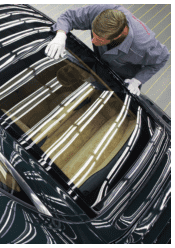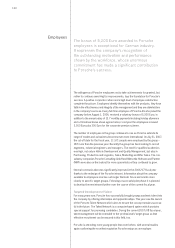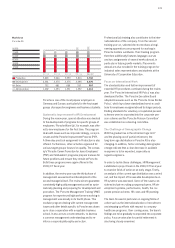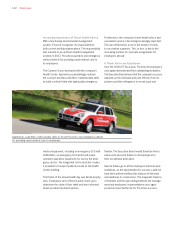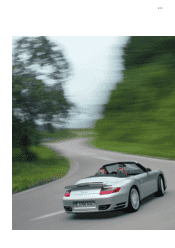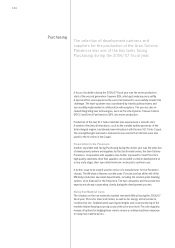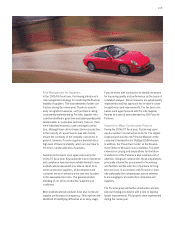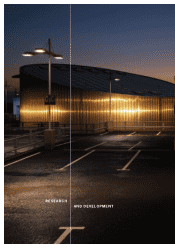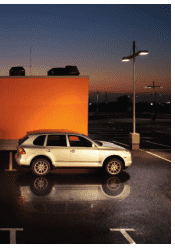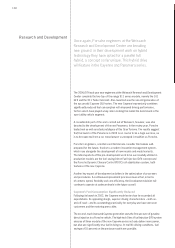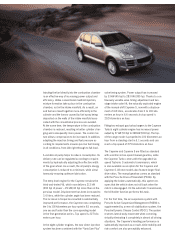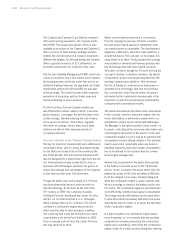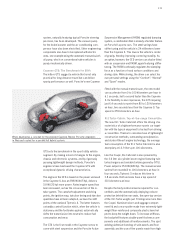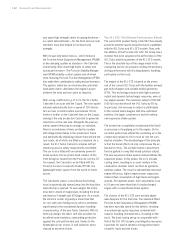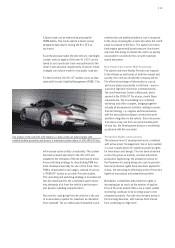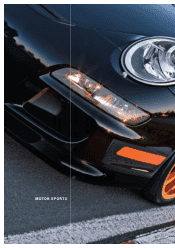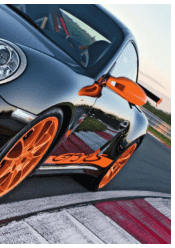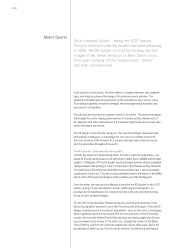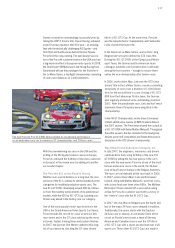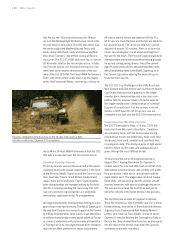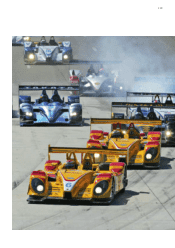Porsche 2006 Annual Report Download - page 111
Download and view the complete annual report
Please find page 111 of the 2006 Porsche annual report below. You can navigate through the pages in the report by either clicking on the pages listed below, or by using the keyword search tool below to find specific information within the annual report.
Injecting the fuel directly into the combustion chamber
is an effective way of increasing power output and
efficiency. Unlike conventional manifold injection,
mixture formation takes place in the combustion
chamber, not in the intake manifold. As a result, air
and fuel are mixed together more efficiently in the
cylinder and the losses caused by fuel spray being
deposited on the walls of the intake manifold asso-
ciated with the conventional process are avoided.
At the same time, the temperature in the combustion
chamber is reduced, resulting in better cylinder char-
ging and consequently more power. The cooler mix-
ture allows compression to be increased. In addition,
adapting the injection timing and fuel pressure ac-
cording to requirements ensures precise fuel mixing
in all conditions, from idle right through to full-load.
A variable oil pump helps to reduce consumption. Its
delivery rate can be regulated according to require-
ments by hydraulically adjusting the effective width
of the gear wheel. As a result, the oil pump’s energy
consumption is reduced to a minimum, while simul-
taneously ensuring optimum lubrication.
The entry-level engine for the Cayenne remains the
tried-and-tested V6, which now delivers 213 kW
(290 hp) of power – 29 kW (40 hp) more than on the
previous model. Displacement has been increased to
3.6 liters, while the cylinder angle has been reduced.
The increase in torque has resulted in substantially
improved performance, the Cayenne now completing
the 0 to 100 kilometers per hour sprint in 8.1 seconds,
one second faster than the corresponding model
in the first-generation series. Top speed is 227 kilo-
meters per hour.
In the eight-cylinder engines, the new direct injection
system has been combined with the “VarioCam Plus”
valve timing system. Power output has increased
by 33 kW (45 hp) to 283 kW (385 hp). Thanks to con-
tinuously variable valve timing adjustment and two-
stage intake valve lift, the naturally-aspirated engine
of the manual-shift Cayenne S, now with a displace-
ment of 4.8 liters, accelerates from 0 to 100 kilo-
meters an hour in 6.6 seconds; its top speed is
252 kilometers an hour.
Fitting two exhaust gas turbochargers to the Cayenne
Turbo’s eight-cylinder engine has increased power
output by 37 kW (50 hp) to 368 kW (500 hp). The top-
of-the-range model is propelled to 100 kilometers an
hour from a standing start in 5.1 seconds and can
reach a top speed of 275 kilometers an hour.
The Cayenne and Cayenne S are fitted as standard
with a reinforced six-speed manual gearbox, while
the Cayenne Turbo comes with the upgraded six-
speed Tiptronic S automatic transmission, which
is also available as an option for the Cayenne and
Cayenne S. All new models also feature longer final-
drive ratios. The manual gearbox comes as standard
with the Porsche Drive-off Assistant (PDOA). By
applying the brakes automatically, this system en-
sures that the vehicle does not roll back when the
clutch is disengaged. On the automatic transmission,
the hill holder function performs this task.
For the first time, the air suspension system with
Porsche Active Suspension Management (PASM) is
supplemented by a new roll stabilization system, the
Porsche Dynamic Chassis Control (PDCC). The system
restricts lateral body movement when cornering,
virtually eliminating it completely in almost all driving
situations. The Cayenne’s handling performance is
substantially improved as a result, while stability and
ride comfort are also perceptibly enhanced.


